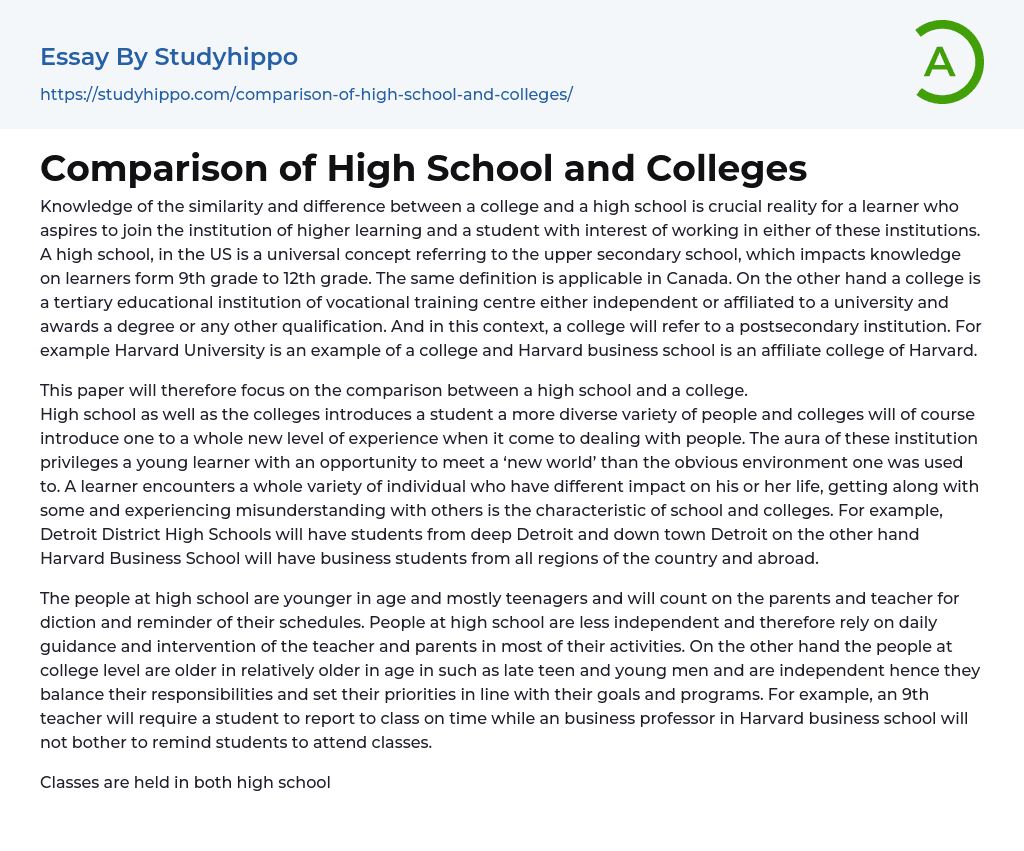It is crucial for students interested in working or pursuing higher education to comprehend the likenesses and distinctions between college and high school institutions.
Both in the US and Canada, a high school is where students gain knowledge from 9th to 12th grade. In contrast, a college is an independent or affiliated vocational training center or tertiary educational institution that grants degrees or other qualifications. It is considered a postsecondary institution. Harvard University serves as an example of a college, and one of its affiliated colleges is Harvard Business School.
This article will discuss the comparison between high school and college. While both institutions expose students to a diverse range of individuals, colleges offer a unique level of experience in terms of social interactions. The atmosphere at these institutions allows young learners to step into an unfamiliar world from their usual environment.
...In both high schools and colleges, students encounter various individuals who have different impacts on their lives. They may form connections with some and face misunderstandings with others, which is a common characteristic shared by both types of educational settings.
For example, Detroit District High Schools attract students from deep Detroit as well as downtown Detroit, while Harvard Business School welcomes business students from all regions of the country and even international students. Furthermore, high school students are typically teenagers who rely on their parents and teachers for guidance and reminders about their schedules.
While high school students rely heavily on guidance and intervention from teachers and parents due to their dependence, college students, typically in their late teens or young adulthood, are more independent. They possess the ability to manage their responsibilities and prioritize their goal
and schedules without external reminders. For example, a 9th grader may require a high school teacher's prompt to attend class punctually, whereas such assistance would be unnecessary for a business professor at Harvard Business School. Despite these differences, both high school and college classes hold equal significance.
Both the Detroit District high school and Harvard business school have a shared aim of promoting academic empowerment. They both believe that regular and scheduled classes are the most effective way to achieve this objective. Consequently, both institutions have dedicated significant resources to constructing classes and hiring qualified professionals to support their mission.
The methods for tracking attendance differ slightly between these schools. In the Detroit District high school, class instructors verify attendance by checking the class roster, while at Harvard business school, professors require students to complete an attendance form during class.
In terms of scheduling, high school classes in the Detroit District are evenly spread out throughout the timetable. Students move from one class to another once they finish the previous one. Typically, high school students spend six hours per day or thirty hours per week attending classes.
On the other hand, college classes vary depending on each student's chosen program of study.
A student's weekly class schedule typically consists of around 15 to 16 hours, with at least one hour break between classes. In high school, students usually have four Chemistry lessons and one literature lesson per week, while in university they have one communication skills class per week. Both high schools and colleges provide various resources like buildings, staff members, academic resources, and extracurricular activities which are crucial for acquiring knowledge. In the Detroit district, there is a library
that can accommodate up to 500 members, whereas Harvard Business School has a library capable of holding up to 5000 members.
When comparing high school and college, it is evident that college offers a greater abundance of resources compared to high school. High schools can operate with limited resources as their main objective is to educate students and prepare them for the next stage of academia. On the other hand, colleges require more sophisticated resources in order to transform their students into skilled individuals, necessitating additional resources.
A clear example of this contrast can be seen between Detroit District high school, which has only one playground, and the University of Columbia, which boasts a sports complex featuring basketball, baseball, and football fields, along with an arena.
In summary, although high school and college have many similarities, college surpasses high school in all aspects. High school prepares students for college, thus having inferior resources and training, while college represents the pinnacle of education where students are empowered to serve society.
- Plans after High School essays
- High School Experience essays
- Accounting essays
- Andrew Carnegie essays
- Automation essays
- Business Cycle essays
- Business Intelligence essays
- Business Model essays
- Business Operations essays
- Business Software essays
- Cooperation essays
- Cooperative essays
- Corporate Social Responsibility essays
- Corporation essays
- Customer Relationship Management essays
- Family Business essays
- Franchising essays
- Harvard Business School essays
- Harvard university essays
- Human Resource Management essays
- Infrastructure essays
- Inventory essays
- Logistics essays
- Management essays
- Manufacturing essays
- Market essays
- Marketing essays
- Multinational Corporation essays
- News Media essays
- Online Shopping essays
- Quality Assurance essays
- Richard Branson essays
- Sales essays
- Selling essays
- Shopping Mall essays
- Small Business essays
- Starting a Business essays
- Stock essays
- Strategy essays
- Structure essays
- Trade Union essays
- Waste essays
- Classroom essays
- College essays
- E-Learning essays
- Elementary School essays
- Examination essays
- Graduate School essays
- High School essays
- History Of Education essays




